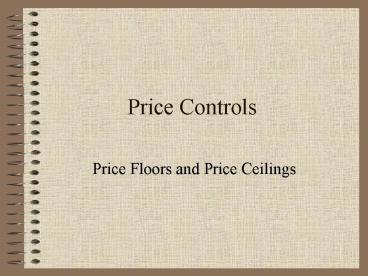Price Controls
About This Presentation
Title:
Price Controls
Description:
Illustrate price ceilings and floors on graphs. ... negative side effects of price controls. Describe and evaluate the arguments for and against price controls. ... – PowerPoint PPT presentation
Number of Views:94
Avg rating:3.0/5.0
Slides: 7
Provided by:
michaelkie
Tags:
price | flash | free | online_training | powerpoint | ppt | pptx | presentation | slide_show | slideshow
Transcript and Presenter's Notes
Title: Price Controls
1
Price Controls
- Price Floors and Price Ceilings
2
Objectives
- Define and describe price floors and price
ceilings. - Illustrate price ceilings and floors on graphs.
- Analyze the effects of price ceilings and floors
in terms of surpluses and shortages - Analyze how prices act as incentives that
influence human behavior. - Describe the negative side effects of price
controls. - Describe and evaluate the arguments for and
against price controls.
3
(No Transcript)
4
(No Transcript)
5
Price Ceiling A Maximum legal price that may be
charged for a good or service set below the
market equilibrium price.
- Persistent shortage develops because quantity
demanded exceeds quantity supplied. - An illegal of Black Market often develops to
supply the commodity. - Prices charged on black markets are often higher
than those that would prevail in the free market.
(Ticket Scalping) - .A substantial portion of revenue falls into the
hands of the illicit supplier instead of going
those who produce the good or perform the
service. - Queuing
- Favored Customers (Discrimination)
- Ration Coupons
- Investment is the industry generally dries up.
6
Price Floor A Minimum legal price that may be
charged for a good or service set above the
market equilibrium price.
- A surplus develops as sellers cannot find enough
buyers. - Where goods are involved, the surplus creates a
problem of disposal. - To get around the regulators, sellers may offer
discounts in disguised and often unwanted forms. - Regulators that keep prices artificial high
encourage over investment in the industry.
Write a Comment
User Comments (0)
Recommended
«
/ »
Page of
«
/ »
CrystalGraphics Presentations
Related Presentations































